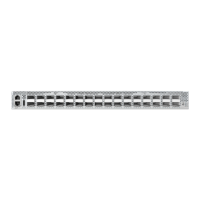C
HAPTER
21
| Multicast Routing
Configuring Global Settings for Multicast Routing
– 546 –
◆ Owner – The associated multicast protocol (PIM-DM, PIM-SM, IGMP
Proxy).
◆ Flags – The flags associated with each routing entry indicate:
■
Dense – PIM Dense mode in use.
■
Sparse – PIM Sparse mode in use.
■
Connected – This route is directly connected to the source.
■
Pruned – This route has been terminated.
■
Register flag – This device is registering for a multicast source.
■
RPT-bit set – The (S,G) entry is pointing to the Rendezvous Point
(RP), which normally indicates a pruned state along the shared tree
for a particular source.
■
SPT-bit set – Multicast packets have been received from a source
on shortest path tree.
■
Join SPT – The rate of traffic arriving over the shared tree has
exceeded the SPT-threshold for this group. If the SPT flag is set for
(*,G) entries, the next (S,G) packet received will cause the router
to join the shortest path tree. If the SPT flag is set for (S,G), the
router immediately joins the shortest path tree.
Downstream Interface List –
◆ Interface – Interface(s) on which multicast subscribers have been
recorded.
◆ State – The flags associated with each downstream interface indicate:
■
Forward – Traffic received from the upstream interface is being
forwarded to this interface.
■
Local – Downstream interface has received IGMP report message
from host in this subnet.
■
Pruned – This route has been terminated.
■
Registering - A downstream device is registering for a multicast
source.
WEB INTERFACE
To display the multicast routing table:
1. Click Multicast, Multicast Routing, Information.
2. Select Show Summary from the Action List.

